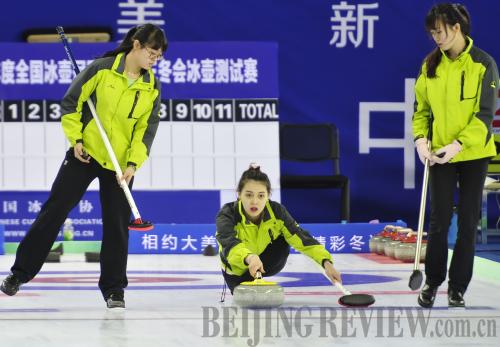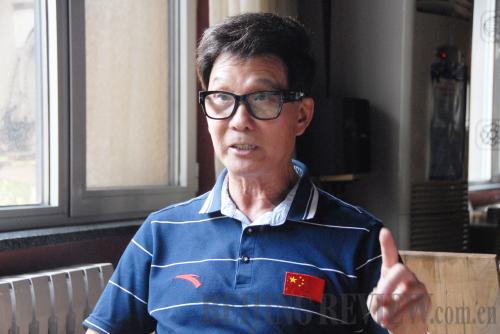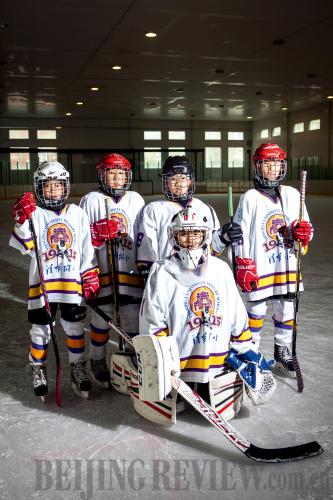|
 |
|
Curlers compete in a national contest in Urumqi, Xinjiang Uygur Autonomous Region, on April 20 (XINHUA) |
After a two-year long bidding journey, Beijing hopes to be named the host city of the 2022 Olympic Winter Games at the 128th Session of the International Olympic Committee (IOC) in Kuala Lumpur, Malaysia on July 31.
Beijing formally announced its bid in November 2013 and then was selected as one of the three candidate cities by the IOC's Executive Board in July 2014. Later that year, Oslo, Norway's capital, withdrew its candidacy, leaving only Kazakhstan's Almaty and Beijing in the bidding race.
Beijing, along with its co-bidding city Zhangjiakou in north China's Hebei Province, has every advantage for the bid for the 2022 Olympic Winter Games, said Zhu Chengyi, former Vice Director of the Winter Sports Management Center of China's State General Administration of Sports (SGAS).
"The rapid economic development, political stability and the popularity of winter sports in China will ensure a successful Olympics," Zhu told Beijing Review, adding that the holding of a Winter Olympics will further promote the development of winter sports in China.
"This means that fervor will be formed around winter sports, helping transform popular sports such as skiing, snowboarding and ice hockey into full-fledged national pastimes and making the country a winter sports power by involving more young people," Zhu said.
 |
|
Zhu Chengyi, former Vice Director of the Winter Sports Management Center of the SGAS (WEI YAO) |
Ready to go
On June 9, the Beijing Winter Olympics bidding team presented its bidding project to the IOC members in Lausanne, Switzerland.
Wang Anshun, Mayor of Beijing and President of the Beijing 2022 Olympic Games Bid Committee, told the IOC members that Beijing would be the safest option to host the 2022 Olympic Winter Games.
"It would be the safest decision for the IOC to choose Beijing, which is the most reliable partner for all stakeholders," Wang said.
Illustrating the legacy of the Beijing 2008 Olympic Games, Wang said that the city of Beijing has fully embraced the Olympic spirit and experiences it every day.
According to Zhu, out of the 12 venues for competition and training required for the 2022 Winter Olympic Games, 11 are existing venues inherited from the Beijing 2008 Olympic Games. "We only need to build a competition venue for speed skating," Zhu said.
Meanwhile, experience in organizing the 2008 Summer Games will help smooth the country's job for the winter Games, providing the athletes with the best experience and ensuring sustainability and cost-efficiency for the Games, Zhu added.
In fact, the concept of sustainability and cost-efficiency has been included in the Olympic Agenda 2020, the IOC's latest reform package, which was approved last year and will serve as a roadmap for future Olympics.
Zhou Xing, a financial official with the Beijing bid committee, said that the budgeting for the 2022 Games will be scientific, prudent, practical and economical.
The budget for the organizing committee is projected to be $1.56 billion, and a further $1.51 billion will be used on infrastructure renovation.
The key theme of sustainability that played a crucial role in the Olympic Agenda 2020 can also be found in Beijing 2022's blueprint for sustainable development through boosting the economic development of the Beijing-Zhangjiakou Sport, Culture and Tourism Belt.
Besides, modern, quick and efficient transportation is another key element of the Beijing 2022 bid.
As an integral part of the government's Beijing-Tianjin-Hebei Intercity Rail Master Plan, the construction of the Beijing-Zhangjiakou high-speed rail link has already begun and will be fully operational by early 2019. The travel time from Beijing to Zhangjiakou will be just 50 minutes, according to Beijing's bidding profile.
As for natural conditions, the bid committee assured the IOC members that there will be enough snow and low temperatures for the Winter Games.
In Beijing's Yanqing County, the temperatures of the designated competition area, located 1,300 meters above sea level, are situated on average between -9 Celsius degrees and -1.1 Celsius degrees, with a stable freezing period from mid-November to the end of March, 140 days on average. In the area, the snow cover reaches a depth of 20.2 cm on average and can go as high as 65 cm.
The temperatures of the designated competition area in Zhangjiakou, located 1,248 meters above sea level, are situated on average between -15.2 Celsius degrees and -9.3 Celsius degrees, with a stable freezing period from the end of October to the beginning of April, 165 days on average. In the area, the snow cover reaches a depth of 21 cm on average and can reach as high as 72 cm.
"Zhangjiakou is already known as a popular ski tourism destination among local citizens, with five ski resorts totaling more than 100 ski tracks successfully operating in the area," Zhu said. "These resorts have become the training bases for ski athletes from China and other Asian countries as well as a popular recreational destination for ski enthusiasts."
Air pollution is another concern for Beijing's bid. Mayor Wang promised that if the bid succeeds, a series of tough measures taken previously by environmental authorities would bring an "Olympic blue" sky in time for the Games.
He explained that Beijing has started a five-year plan to clean the air since 2013. With a total investment of $130 billion in five years, Beijing expects to cut the density of PM2.5, airborne particles smaller than 2.5 microns in diameter, by 20 percent in 2017.
"We are confident that we can have fresh air in Beijing, not only by significantly improving the air quality, but also by paving a new, healthier and greener path for the city and the surrounding region's development for years to come," Wang said.
"A successful bid will surely help speed up the cities' pace in easing pollution, and the two-city bid will help the Beijing-Tianjin-Hebei region better coordinate their efforts to fight pollution," said Wang Hui, Vice General Secretary of the Beijing 2022 Olympic Games Bid Committee.
Additionally, the enormous enthusiasm and expectations of the Chinese people will be also a key factor in the IOC vote. "Success will not be possible without people's support and social stability," said Wu Jingmi, General Secretary of the Beijing Olympic City Development Association.
A survey by the Beijing bid committee shows that more than 90 percent of the people in China questioned hold supporting attitudes to hosting the Winter Games.
"Mass support by the Chinese people is one of the biggest advantages owned by Beijing," Wu said.
"With strong public support, a government guarantee, sound natural conditions, comprehensive experience in Games organization and your guidance, we are confident that all potential risks could be effectively managed," Mayor Wang told the IOC members on June 9.
 |
|
Child hockey players from the Elementary School Affiliated to Tsinghua University in Beijing (QIN BIN) |
A bright future
Liu Peng, head of both the Chinese Olympic Committee (COC) and the SGAS, said in Lausanne on June 9 that Beijing's bid for the 2022 Winter Olympic Games will boost participation and involvement in winter sports across the country, open a bright future for winter sports in China, Asia and the world, as China has set off on an ambitious "Long March" to get 300 million Chinese people involved in skiing and skating events.
"Winter sports have had a long history, great popularity and bright future in China. The National Winter Games are held in China every four years, and the 13th Winter Games will be staged next year," Liu said.
Liu told IOC members that China has successfully hosted two Asian Winter Games, one Winter Universiade and many international and continental winter sports championships in the past years.
"To enhance the popularity of winter sports, we should enlarge the personnel base first. The most efficient way is to inspire more ordinary people, especially youngsters, to take part in the sports," said Zhu.
Winter sports have been gaining popularity in China since 2002. In the past decade, the number of skating rinks in China increased from 30 to more than 300 and more than 300 skiing resorts were built across the country, attracting approximately 30 million visitors, according to Zhu.
During the Chinese New Year holiday this February, 1.5 million tourists went to Zhangjiakou's skiing resorts, leading to a 25 percent year-on-year increase, according to local statistics.
According to Xiao Huanwei, CEO of the Court Dense International Tourist Resort in Zhangjiakou's Chongli County, his skiing resort has seen a 16 percent increase in the number of young tourists in recent two years. "With such growing speed, the number of people participating in skiing in China will surpass other countries in 2022," Xiao said.
Yu Donglin, General Manager of Wanlong Ski Resort in Chongli, said that his resort has also witnessed a sharp rise in the tourists' number. "In the snow season of 2014-15, an 80 percent year-on-year increase in the number of tourists was recorded, while a 30-percent growth was recorded in 2013-14," Yu said.
Another development is that more southern regions have also taken part in the winter sports. According to Zhu, one third of current ski courts are in south China, and more than 100 skating rinks have been built in the southern regions.
According to Huang Yongping, Director of Shanghai Municipal Physical Culture Bureau, the city currently has 11 skating rinks and five skating clubs, attracting more than 100 former skating athletes to come to Shanghai.
In June, the Government of Hepu County in southwest China's Guangxi Zhuang Autonomous Region applied to build a skating rink. "Although the small county only has a population of 2 million, they said it's the situation that drove them to consider building the rink because more and more young people in the county have started participating in the skating sport," Zhu said.
"It's a good sign to the country's winter sports because China is still a developing country in the sports," he added.
Zhu took ice hockey as an example to explain the situation. In Sweden, there are 327 indoor skating rinks, with 15,685 male and 3,612 female professionals taking part in ice hockey.
In another winter sport giant Canada, there are 2,450 indoor skating rinks, with more than 90,000 male and 80,000 female professionals taking part in the sport.
Meanwhile, in China, there are only less than 40 standard indoor skating rinks with fewer than 100 male and 100 female professionals taking part in ice hockey.
"I believe greater participation in winter sports on a local level will finally trickle through to national level so that one day we will have a bigger talent pool to select from," Zhu said.
Copyedited by Kylee McIntyre
Comments to yinpumin@bjreview.com | 